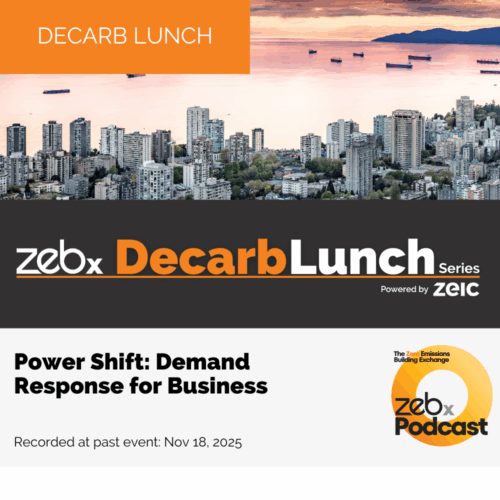
Be Part of it: The BC Green Building Calendar is Live
January 17, 2022
Jan 2022 Decarb Lunch Podcast: Reducing Embodied Carbon for Step Code Homes
January 28, 2022
Deep Emissions Retrofit Dialogue Four – Caution! Blind Spots Ahead.
Recorded at Past Event: Jan 20, 2022
Slides:
Summary
The biggest source of future operational emissions from the building sector will come from existing, rather than newly constructed buildings. Retrofits which prioritize massive reductions in operational emissions are essential to address the climate crisis and help the Province and local governments achieve their emissions reductions goals. These kinds of retrofits will need to be scaled up dramatically over the next decade. In British Columbia, electrification is the most effective strategy to achieve deep, immediate, and real emissions reductions.
This Deep Emissions Retrofit Dialogue was co-hosted with BC Hydro and was the fourth in a six-part series focused on deep emissions retrofits. The three presenters kicked off the dialogue with presentations focused on managing refrigerants, ensuring affordability for low-income households and BC Hydro’s integrated resource planning.
Managing Refrigerants as BC Scales up Deep Emissions Retrofits
Presented by Bhavin Degadwala and Justin TK Chin, Integral Group
The global warming potential (GWP) of refrigerant leakage can be significant. In addition to its GWP, refrigerants also contribute to ozone depletion. According to the US’s EPA, current leakage rates are estimated to be between 15% (comfort cooling and other appliances) to 35% (commercial and industrial refrigeration). In Canada, there is no reliable data regarding leakage rates and amounts. According to Project Drawdown, “over 30 years, preventing 100 percent of refrigerant leaks that otherwise would be released can avoid emissions equivalent to 57.15 gigatons of carbon dioxide.” Most leakage happens at the end of equipment or appliance service life (95%).
Heat pumps contain refrigerants and are often used to replace gas-fired equipment in an attempt to reduce operational emissions. If a refrigerant with a high GWP leaks from a system installed for this purpose, it could undo a portion of the emissions reductions achieved by fuel-switching.
Current federal and provincial regulations are not stringent enough to enforce on-site reuse, recycling or recovery of the refrigerants from existing systems that are being decommissioned. Nor are there regulations that limit the system charge for high-GWP refrigerants.
Project teams and operations staff can mitigate the risks associated with refrigerant leakage by:
- designing new systems to operate on low or medium pressure and low-GWP refrigerants (although Canadian codes and regulations are not yet adapted to accept all new, low-GWP refrigerants such as propane),
- selecting packaged refrigeration systems that do not require any field installation of refrigerant piping
- ensuring that installation and maintenance is done by a qualified technician or contractor
- conducting regular leak tests (up to twice per year), and
- recording and reporting any accidental leakage occurring during operation or replacement.
For more information on best practices to reduce the risk of refrigerant leakage, we suggest reading Elementa’s Best Practice Guide.
Addressing the Affordability Impact of Deep Emissions Retrofits on Low-Income Households
Presented by Jordan Fisher, FRESCo Building Efficiency
Multiple factors are converging to drive the demand for deep emissions retrofits: an aging building stock, high operating costs, the need for emissions reductions, and an increasing focus on indoor comfort and health. As the climate warms, overheating is becoming an increasing health risk and the safety of vulnerable populations is at risk. Temporary comfort solutions to overheating include portable air conditioning units that are often low-efficiency, lead to higher electrical bills and pose potential safety risks.
Older buildings typically provide lower cost housing compared to new buildings. It is important to prioritize the preservation of these buildings and improve their energy efficiency because for low-income households, utility costs are a major expense.
Because a singular focus on emissions reductions could result in an increase in utility costs, a holistic retrofit approach that includes the building envelope and mechanical systems is needed when dealing with low-income households. In addition, to avoid renovictions for renters, projects should be planned to ensure that tenants can remain in place during the retrofit.
BC Hydro’s Integrated Resource Plan: Flexible Resources for an Uncertain Future
Presented by Alex Tu, BC Hydro
The Integrated Resource Plan (IRP) is BC Hydro’s high-level strategy to address the growing electrical load on its integrated power system that covers almost all of the province. Its current IRP extends out to 2040. It focuses on the gap between forecasted electricity supply and demand based on a reference load that is expected to grow over the next 20 years.
BC Hydro expects that electric vehicles will be the largest component in residential load growth. Commercial load growth is expected to begin increasing in 2024, but it may occur sooner depending on the economic recovery following the pandemic. The industrial sector is harder to predict, but is expected to grow as a result of the electrification of the oil and gas sector’s industrial processes. The growth projections take into consideration provincial legislation and policies such as the Clean Energy Act, the Zero Emission Vehicle Act and the CleanBC Plan.
To meet the expected load growth and prepare for uncertainties, BC Hydro will be relying on flexible demand-side measures (including voluntary time-of-use metering), the renewal of near-term clean electricity purchase agreements, and transmission system upgrades. By implementing these strategies, BC Hydro estimates that it will have enough energy to serve the load on its integrated grid until approximately 2029 and enough capacity (power) until approximately 2032. The load for the South Coast grid is likely to exceed regional capacity sooner.
The IRP includes an accelerated electrification scenario that forecasts up to 60% growth in demand by 2040. To prepare for the possibility of accelerated electrification, BC Hydro is studying the deployment of utility-scale batteries, specifically for the South Coast grid, more and higher levels of demand-side management, a call for more energy provision agreements and capacity upgrades at existing generation facilities. Incentives for distributed solar arrays (on rooftops) are not included in current plans due to cost.
Presenters
Bhavin Degadwala, Associate Principal, Integral Group
Bhavin is one of the Contributors to Integral Group’s Refrigerants & Environmental Impacts – A Best Practice Guide. He is a mechanical engineer with over seven years of experience designing mechanical systems for a variety of project types, including large-scale commercial offices, community spaces, healthcare facilities, and laboratories. His designs are driven by a focus on occupant health and comfort. Bhavin’s diverse project experience allows him to address complex design within an integrated structure while staying on schedule.
Justin TK Chin, Associate Principal, Integral Group
Justin is a mechanical engineer and Certified Passive House Designer with deep technical experience in the green building industry. With a pragmatic design approach, he creates project-specific solutions specializing in both building-level systems and institutional and campus-scale district energy systems. Justin emphasizes using an integrated process to ensure all stakeholder needs are met and to provide simple, elegant, and practical solutions to the client.
Jordan Fisher, President and Program Manager, FRESCo Building Efficiency
Jordan has been providing services related to the improvement of energy efficiency in new and existing residential buildings for over 15 years. He is an experienced project manager, energy/business case analyst, and is a Professional Planner. He has diverse experience in energy/water conservation, green building and infrastructure, cost consulting, community sustainability, and energy/emissions planning. Jordan has been the project lead for numerous building energy efficiency and GHG reduction projects in the private and public sectors, including over 25 million square feet of buildings of various types and sizes and a variety of planning/policy initiatives.
Alex Tu, Senior Strategic Technical Specialist, BC Hydro
Alex Tu has worked in the utility sector for 20 years in roles related to technology innovation, sustainability and resource planning. He has a bachelor degree in natural science from McGill University and a master degree in public policy from Simon Fraser University. Alex has been with BC Hydro since 2004 and works currently in the Energy Planning Department focusing on alternative and emerging energy resources.
Hosts
Roberto Pecora, Director, ZEBx
Robyn Wark, Manager of Advanced Demand Side Management, BC Hydro







